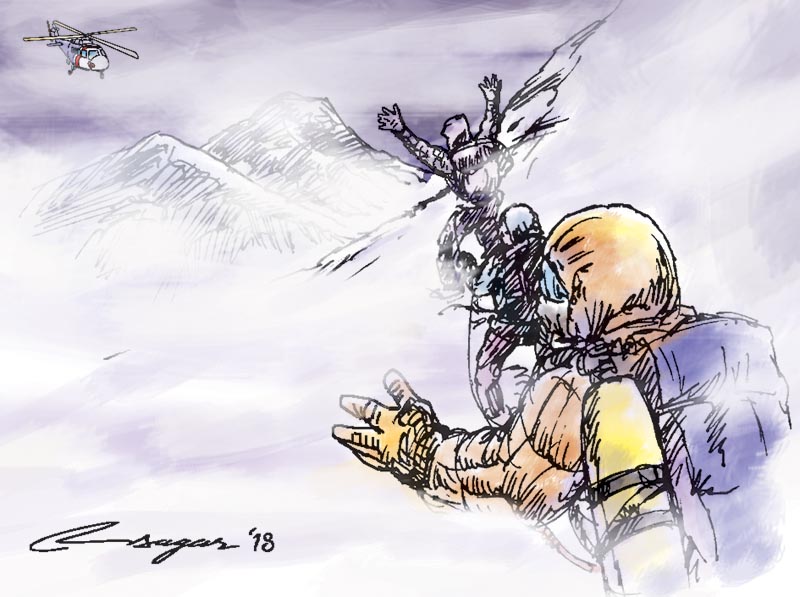Rescue in Himalayas: The other chopper story
Due regard needs to be given to the unique circumstances of the Himalaya in conjunction with insurers and services providers who are truly interested to provide products that respond appropriately to the risks
I was on Mt Manaslu (8,156m), the world’s 8th highest mountain in Nepal, when a devastating avalanche hit Camp 3 around 4.30am on September 23, 2012, with debris flying down its slopes burying many tents at Camp 2. My (now) husband and I were asleep at Camp 2 when the avalanche struck. We awoke to the feeling of being quickly buried. Luckily, we were able to get out of our tent. We then helped to dig out our friends in the tent beside us. We heard shouting over a radio that there was a problem at Camp 3: there were many fatalities and many more injured.
My husband and some others who were acclimatised quickly departed Camp 2 and raced up to Camp 3, as fast as they could. I remained at Camp 2 to look after another climber. At first light, those of us still at Camp 2 waited, and waited, and waited, looking to the sky, on radios, and listening for the sound overhead of helicopters heading to the site of the devastation.
Meanwhile, at Camp 3, one of the climbers that my husband had dug out was still alive and remained so for some time. Sadly, the climber died around one hour before the first rescue helicopter arrived, which was some hours after the avalanche occurred.
In many countries where climbing accidents occur in alpine environments, and tried and tested policies and procedures for helicopter rescues are in place, helicopters can arrive within minutes of an incident and those injured (or not) are whisked to safety. Questions about who will pay often come later.
The Himalaya presents climbers, trekkers, tourism operators and insurance companies with additional challenges for rescue-type situations. Considerations include weather, distances, communications, high altitude, terrain, the need for specialised helicopters and suitably experienced helicopter pilots. In such environments, it is necessary to also take into account helicopter availability (including the type of helicopter that is suited to the altitude), ferrying of enough fuel, weather conditions, and which helicopter pilots are available to fly and land safely in the prevailing conditions, at high altitude and landing on precarious terrain. Everything has to come together in order to perform a safe and effective rescue in these environments.
Over the last 10 or so years, when on many climbing expeditions and treks into the heart of the Himalaya, insurance policies and wording in contract clauses have been a common discussion amongst climbers and trekkers at base camps and lodges on mountains and trails, normally precipitated by the nearby whirring of helicopter blades. We see someone being helped onto a helicopter, and with reflection by those left behind, involved or not-involved (‘there but for the grace of the universe go I’ types of scenarios), discussions invariably turn to what type of medical evacuation cover people hold. People will say which company they are using for their insurance and why it is good, or not.
Then, if I know the policy, I tell them their insurance policy doesn’t cover them for A, B or C, and they look at me dazed and confused. Then, there are ‘member services’ arrangements where the service providers will be at pains to tell members that they (the service providers) are not an insurance company so then you are left to wonder ‘what am I paying for?’.
When trying to decide whether, in recent times, a ‘member services’ arrangement was suitable for a high risk remote expedition, I made enquiries of the relevant services provider only to be told that before their helicopter services could be authorised a member had to speak to the services provider. After posing many hypothetical scenarios that can apply in the Himalaya where the situation would mean that the member could not personally speak directly to the services provider, they continued to maintain their position.
Then, when I gave a simpler hypothetical example where direct contact was impossible—such as a member being down a crevasse without a radio, or with a broken radio (due to a fall) or being unconscious—they revised their response. I also drew to their attention a specific clause in their agreement with members that contradicted the advice I was being given. In the current public discussion on helicopters in Nepal, the evidence seems to show that there are many unwarranted helicopter movements in the Himalaya, and maybe not just in Nepal, where insurance companies and services providers are being asked to pay for services in circumstances where they should not. In addition, some hospitals and others seem to be on a merry gravy train.
But, it would be a mistake to think the solution in a high altitude, remote, environment is a simple one and that a quickly installed new solution is the right one. Due regard needs to be given to the unique circumstances of the Himalaya, whether in Nepal or elsewhere, in conjunction with insurers and services providers who are truly interested to provide products that respond appropriately to the risks.
Insurers (and providers of ‘member services’) need to up their game and learn more from an underwriting, actuarial, policy, and claims perspective about the risks associated with products to support their customers’ needs across the Himalaya.
Burke is a high altitude mountaineer and lawyer based in Sydney






